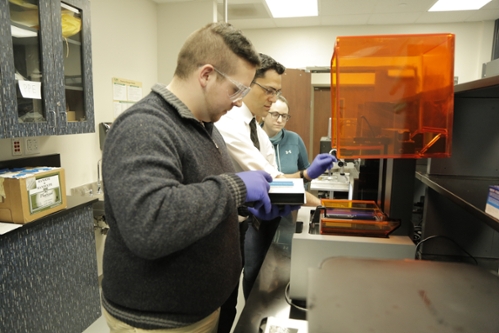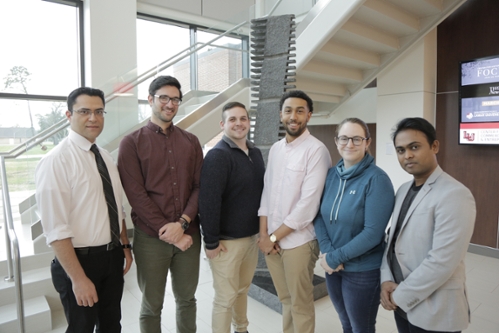Self-Healing material has limitless applications
An exciting, newly-developed material has been created by a team of researchers led by Prof. Keivan Davami, the director of Nano-Micro-Macro manufacturing group, at Lamar University. Using advanced, laser-assisted stereolithography (SLA) additive manufacturing techniques, the team was successful in fabricating a material  capable of autonomic self-repair facilitated by nothing more than exposure to ultraviolet (UV) light. Their groundbreaking work has been published in Scientific Reports, part of the prestigious Nature publishing group. A story about the research is also published in "New Atlas."
capable of autonomic self-repair facilitated by nothing more than exposure to ultraviolet (UV) light. Their groundbreaking work has been published in Scientific Reports, part of the prestigious Nature publishing group. A story about the research is also published in "New Atlas."
According to their research, this novel material draws inspiration from nature. A series of reservoirs trap the self-healing resin within the material itself, only releasing upon the event of fracture. This mechanism is analogous to microvascular blood networks present in human skin that facilitate tissue restoration upon injury. However, instead of blood escaping to the surface of an injury, the UV-sensitive resin is allowed to escape via capillary action, delivering only what is required to restore isolated fractures. The autonomic functionality of the self-healing mechanism means that next to no intervention is required to repair the damaged material save for short exposure to UV light which can be done remotely. This is especially crucial for hard-to-reach device components and removes the need for costly and time-consuming disassembly.
 The benefits of this material will be especially impactful for everyday items prone to failure from tools, eyeglasses and device components to the soles of shoes, which can be quickly and easily repaired by the simple exposure to UV light. Not only will this lead to higher working times of important items we rely upon throughout our daily lives but will also reduce the amount of waste delivered to landfills. With this material, the need to replace many broken items will no longer be necessary.
The benefits of this material will be especially impactful for everyday items prone to failure from tools, eyeglasses and device components to the soles of shoes, which can be quickly and easily repaired by the simple exposure to UV light. Not only will this lead to higher working times of important items we rely upon throughout our daily lives but will also reduce the amount of waste delivered to landfills. With this material, the need to replace many broken items will no longer be necessary.
The team believes this material is a step in the right direction in reducing the amount of waste generated by damage that could otherwise be repaired if they were constructed by the self-healing material.
The group has successfully proven that clever design coupled with modern additive manufacturing techniques allow for rapid innovations that are capable of significant and far-reaching improvements in modern society. The group is currently working to reduce the energy requirements for self-healing to occur, meaning healing will be totally unreliant on human intervention where only ambient UV light sources (such as sunlight) will be needed.
The Lamar University researchers and co-authors on the paper are: Dr. Keivan Davami, Mehrdad Mohsenizadeh, Morgan Mitcham, Praveen Damasus, Quintin Williams, and Michael Munther.
 capable of autonomic self-repair facilitated by nothing more than exposure to ultraviolet (UV) light. Their groundbreaking work has been published in Scientific Reports, part of the prestigious Nature publishing group. A story about the research is also published in "New Atlas."
capable of autonomic self-repair facilitated by nothing more than exposure to ultraviolet (UV) light. Their groundbreaking work has been published in Scientific Reports, part of the prestigious Nature publishing group. A story about the research is also published in "New Atlas." According to their research, this novel material draws inspiration from nature. A series of reservoirs trap the self-healing resin within the material itself, only releasing upon the event of fracture. This mechanism is analogous to microvascular blood networks present in human skin that facilitate tissue restoration upon injury. However, instead of blood escaping to the surface of an injury, the UV-sensitive resin is allowed to escape via capillary action, delivering only what is required to restore isolated fractures. The autonomic functionality of the self-healing mechanism means that next to no intervention is required to repair the damaged material save for short exposure to UV light which can be done remotely. This is especially crucial for hard-to-reach device components and removes the need for costly and time-consuming disassembly.
 The benefits of this material will be especially impactful for everyday items prone to failure from tools, eyeglasses and device components to the soles of shoes, which can be quickly and easily repaired by the simple exposure to UV light. Not only will this lead to higher working times of important items we rely upon throughout our daily lives but will also reduce the amount of waste delivered to landfills. With this material, the need to replace many broken items will no longer be necessary.
The benefits of this material will be especially impactful for everyday items prone to failure from tools, eyeglasses and device components to the soles of shoes, which can be quickly and easily repaired by the simple exposure to UV light. Not only will this lead to higher working times of important items we rely upon throughout our daily lives but will also reduce the amount of waste delivered to landfills. With this material, the need to replace many broken items will no longer be necessary. The team believes this material is a step in the right direction in reducing the amount of waste generated by damage that could otherwise be repaired if they were constructed by the self-healing material.
The group has successfully proven that clever design coupled with modern additive manufacturing techniques allow for rapid innovations that are capable of significant and far-reaching improvements in modern society. The group is currently working to reduce the energy requirements for self-healing to occur, meaning healing will be totally unreliant on human intervention where only ambient UV light sources (such as sunlight) will be needed.
The Lamar University researchers and co-authors on the paper are: Dr. Keivan Davami, Mehrdad Mohsenizadeh, Morgan Mitcham, Praveen Damasus, Quintin Williams, and Michael Munther.
Posted on Thu, May 16, 2019 by Shelly Vitanza


